Статьи журнала - International Journal of Information Technology and Computer Science
Все статьи: 1165
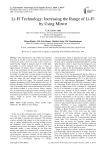
Li-Fi technology: increasing the range of Li-Fi by using mirror
Статья научная
Data transmission is one of the most important term used in our day to day activities in the fast-growing world. Li-Fi opens a new era to that. Li-Fi is known as Light Fidelity. Simply it transmits data by visible light. According to recent research Li-Fi has a range of approximately 10 meters. Also, it cannot pass through wall or any solid object. So, this research focuses mainly to increase the 10-meter range. For a regular sized room this range is enough. But if anyone wants to provide data inside a big hall or in any large room, it is not possible by only this range. He must provide more LED that is connected to the Li-Fi router. This research focuses to optimize the number of LED and to minimize the cost. To increase the range of LED two methods are proposed here. One of the method deals with the positioning of the LEDs and another method is to use concave mirror. Smarter way of positioning of light gives better coverage of light that increases the range of LED. As concave mirror gives real and increased mirror for a particular positioning of an object, which is proved both theoretically and mathematically.
Бесплатно
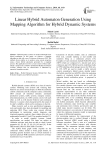
Linear Hybrid Automaton Generation Using Mapping Algorithm for Hybrid Dynamic Systems
Статья научная
Hybrid dynamic systems are analyzed through linear hybrid automaton. In this paper, we propose a mapping algorithm to deal with a new Continuous elementary HPN. The method shown enables us to analyze some system properties using a linear hybrid automaton generated by a mapping process. The application involves a water system of three tanks, which is analyzed by a PHAVer (Polyhedral Hybrid Automaton Verifier) software tool. Its effectiveness is illustrated by numerical simulation results.
Бесплатно
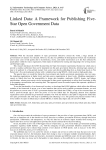
Linked Data: A Framework for Publishing Five-Star Open Government Data
Статья научная
With the increased adoption of open government initiatives around the world, a huge amount of governmental raw datasets was released. However, the data was published in heterogeneous formats and vocabularies and in many cases in bad quality due to inconsistency, messy, and maybe incorrectness as it has been collected by practicalities within the source organization, which makes it inefficient for reusing and integrating it for serving citizens and third-party apps. This research introduces the LDOG (Linked Data for Open Government) experimental framework, which aims to provide a modular architecture that can be integrated into the open government hierarchy, allowing huge amounts of data to be gathered in a fine-grained manner from source and directly publishing them as linked data based on Tim Berners lee’s five-star deployment scheme with a validation layer using SHACL, which results in high quality data. The general idea is to model the hierarchy of government and classify government organizations into two types, the modeling organizations at higher levels and data source organizations at lower levels. Modeling organization’s experts in linked data have the responsibility to design data templates, ontologies, SHACL shapes, and linkage specifications. whereas non-experts can be incorporated in data source organizations to utilize their knowledge in data to do mapping, reconciliation, and correcting data. This approach lowers the needed experts that represent a problem of linked data adoption. To test the functionality of our framework in action, we developed the LDOG platform which utilizes the different modules of the framework to power a set of user interfaces that can be used to publish government datasets. we used this platform to convert some of UAE's government datasets into linked data. Finally, on top of the converted data, we built a proof-of-concept app to show the power of five-star linked data for integrating datasets from disparate organizations and to promote the governments' adoption. Our work has defined a clear path to integrate the linked data into open governments and solid steps to publishing and enhancing it in a fine-grained and practical manner with a lower number of experts in linked data, It extends SHACL to define data shapes and convert CSV to RDF.
Бесплатно
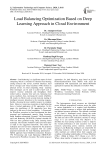
Load Balancing Optimization Based On Deep Learning Approach in Cloud Environment
Статья научная
Load balancing is a significant aspect of cloud computing which is essential for identical load sharing among resources like servers, network interfaces, hard drives (storage) and virtual machines (VMs) hosted on physical servers. In cloud computing, Deep Learning (DL) techniques can be used to achieve QoS such as improve resource utilization and throughput; while reduce latency, response time and cost, balancing load across machines, thus, increasing the system reliability. DL results in effective and accurate decision making of intelligent resource allocation to the incoming requests, thereby, choosing the most suitable resource to complete them. However, in previous researches on load balancing, there is limited application of DL approaches. In this paper, the significance of DL approaches have been analysed in the area of cloud computing. A Framework for Workflow execution in cloud environment has been proposed and implemented, namely, Deep Learning- based Deadline-constrained, Dynamic VM Provisioning and Load Balancing (DLD-PLB). Optimal schedule for VMs has been generated using Deep Learning based technique. The Genome workflow tasks have been taken as input to the suggested framework. The results for makespan and cost has been computed for the proposed framework and has been compared with our earlier proposed framework for load balancing optimization - Hybrid approach based Deadline-constrained, Dynamic VM Provisioning and Load Balancing (HDD-PLB)” framework for Workflow execution. The earlier proposed approaches for load balancing were based on hybrid Predict-Earliest-Finish Time (PEFT) with ACO for underutilized VM optimization and hybrid PEFT-Bat approach for optimize the utilization of overflow VMs.
Бесплатно
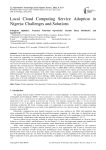
Local Cloud Computing Service Adoption in Nigeria: Challenges and Solutions
Статья научная
Cloud momentum seems unstoppable in Nigeria, as businesses and organizations in the country see less and less advantage in the slog of maintaining their infrastructure. The shift to the cloud in today's COVID-19 driven world has created an opportunity for investments to improve local cloud computing services. However, there are key challenges that must be addressed by the local cloud service providers in the country in order not to lose out to the foreign cloud service providers. This paper assessed the challenges to local cloud computing services adoption among sixty-seven (67) businesses and organizations in Nigeria. The research employed a non-probability purposive sampling approach. The surveyed data were obtained through an online form which was distributed via Linkedln. Descriptive and inferential analysis was used in analyzing the collected data via IBM SPSS software. Findings from the research showed the key challenges to include inadequate awareness of local cloud service vendors, poor innovation and local content, inadequate cloud infrastructure, local cloud vendor interoperability issue, national insecurity, shortages in skilled personnel, Service Level Agreement (SLA), security strategies, privacy, compliance terms, and requirements issues. Thus, adequate local cloud service offerings, skilled personnel, and the IT infrastructural backbone of the country have to be well established to increase the trust in local cloud computing, open up Nigeria to offshore markets while driving economic competitiveness and growth.
Бесплатно
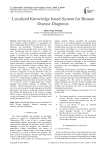
Localized Knowledge based System for Human Disease Diagnosis
Статья научная
Knowledge based system can be designed to solve complex medical problems. It incorporates the expert’s knowledge that has been coded into facts, rules, heuristics and procedures. Incorporation of local languages with the knowledge based system allows end-users communicate with the system in a simpler and easier way. In this study a localized knowledge based system is developed for TB disease diagnosis using Ethiopian national language. To develop the localized knowledge based system, tacit knowledge is acquired from domain experts using interviewing techniques and explicit knowledge is captured from documented sources using relevant documents analysis method. Then the acquired knowledge is modeled using decision tree structure that represents concepts and procedures involved in diagnosis of disease. Production rules are used to represent domain knowledge. The localized knowledge based system is developed using SWI Prolog version 6.4.1 programming language. Prolog supports natural language processing feature to localize the system. As a result, the system is implemented using Amharic language (the national language of Ethiopia) user interface. With Localization, users at remote areas and users who are not good in foreign languages are benefited enormously. The system is tested and evaluated to ensure that whether the performance of the system is accurate and the system is usable by physicians and patients. The average performance of the localized knowledge based system has registered 81.5%.
Бесплатно
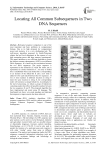
Locating All Common Subsequences in Two DNA Sequences
Статья научная
Biological sequence comparison is one of the most important and basic problems in computational biology. Due to its high demands for computational power and memory, it is a very challenging task. The well-known algorithm proposed by Smith-Waterman obtains the best local alignments at the expense of very high computing power and huge memory requirements. This paper introduces a new efficient algorithm to locate the longest common subsequences (LCS) in two different DNA sequences. It is based on the convolution between the two DNA sequences: The major sequence is represented in the linked-list X while the minor one is represented in circular linked-list Y. An array of linked lists is established where each linked list is corresponding to an element of the linked-list X and a new node is added to it for each match between the two sequences. If two or more matches in different locations in string Y share the same location in string X, the corresponding nodes will construct a unique linked-list. Accordingly, by the end of processing, we obtain a group of linked-lists containing nodes that reflect all possible matches between the two sequences X and Y. The proposed algorithm has been implemented and tested using C# language. The benchmark test shows very good speedups and indicated that impressive improvements has been achieved.
Бесплатно
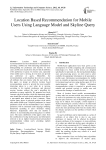
Location Based Recommendation for Mobile Users Using Language Model and Skyline Query
Статья научная
Location based personalized recommendation has been introduced for the purpose of providing a mobile user with interesting information by distinguishing his preference and location. In most cases, mobile user usually does not provide all attributes of his preference or query. In extreme case, especially when mobile user is moving, he even does not provide any preference or query. Meanwhile, the recommendation system database also does not contain all attributes that can express what the user needs. In this paper, we design an effective location based recommendation system to provide the most possible interesting places to a user when he is moving, according to his implicit preference and physical moving location without the user’s providing his preference or query explicitly. We proposed two circle concepts, physical position circle that represents spatial area around the user and virtual preference circle that is a non-spatial area related to user’s interests. Those skyline query places in physical position circle which also match mobile user’s implicit preference in virtual preference circle will be recommended. User’s implicit preference will be estimated under language modeling framework according to user’s historical visiting behaviors. Experiments show that our method is effective in recommending interesting places to mobile users. The main contribution of the paper comes from the combination of using skyline query and information retrieval to do an implicit location-based personalized recommendation without user’s providing explicit preference or query.
Бесплатно
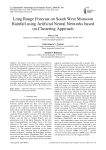
Статья научная
The purpose of this study is to forecast Southwest Indian Monsoon rainfall based on sea surface temperature, sea level pressure, humidity and zonal (u) and meridional (v) winds. With the aforementioned parameters given as input to an Artificial Neural Network (ANN), the rainfall within 10x10 grids of southwest Indian regions is predicted by means of one of the most efficient clustering methods, namely the Kohonen Self-Organizing Maps (SOM). The ANN is trained with input parameters spanning for 36 years (1960-1995) and tested and validated for a period of 9 years (1996-2004). It is further used to predict the rainfall for 6 years (2005-2010). The results show reasonably good accuracy for the summer monsoon periods June, July, August and September (JJAS) of the validation years.
Бесплатно
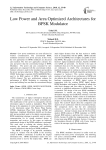
Low power and area optimized architectures for BPSK modulator
Статья научная
Low power modulators are most efficient for wireless communication. The conventional BPSK modulator consumes more power and area. In this work, the new approaches for BPSK modulator are discussed and recorded. The four new approaches consume less area and power than the conventional design of BPSK Modulator. The power and area consumed by new approaches are compared with the conventional method. Cadence software is used for the simulation and synthesis, the power and area reduction in 180nm, 90nm and 45nm CMOS Technology is reported, MATLAB/SIMULINK is used to do BER analysis of BPSK modulator with AWGN channel. The new architectures enhance the performance of BPSK Modulator in consuming less power and utilizing less area than the conventional design.
Бесплатно
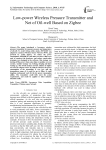
Low-power Wireless Pressure Transmitter and Net of Oil-well Based on Zigbee
Статья научная
The paper introduced a low-power wireless pressure transmitter for measure pressure and temperature of oil-well. To avoid wiring cables onsite, ZICM2410 was adopted to construct Wireless Sensor Network (WSN), and powered by Li-Ion battery. To reduce the power consumption, MSP430F477 and other low-power chips were used to construct the hardware, and energy conservation strategies were designed in the software. One strategy was turning off the power when some chips or modules were not on duty. Another strategy was working, sleeping and timer waking up. The SNAP wireless network solution of Zigbee was used to compose WSN. By analysis and test, the power consumption of the transmitter is very low, and the transmission range of it could be up to 300m. It could longtime continuously work for the low power consumption ability. The transmitter could fully meet the actual requirements, and could be applied to other industry situations easily.
Бесплатно

L–Diversity-Based Semantic Anonymaztion for Data Publishing
Статья научная
Nowadays, publishing data publically is an important for many purposes especially for scientific research. Publishing this data in its raw form make it vulnerable to privacy attacks. Therefore, there is a need to apply suitable privacy preserving techniques on the published data. K-anonymity and L-diversity are well known techniques for data privacy preserving. These techniques cannot face the similarity attack on the data privacy because they did consider the semantic relation between the sensitive attributes of the data. In this paper, a semantic anonymization approach is proposed. This approach is based on the Domain based of semantic rules and the data owner rules to overcome the similarity attacks. The approach is enhanced privacy preserving techniques to prevent similarity attack and have been implemented and tested. The results shows that the semantic anonymization increase the privacy level and decreases the data utility.
Бесплатно
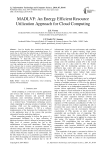
MADLVF: An Energy Efficient Resource Utilization Approach for Cloud Computing
Статья научная
Last few decades have remained the witness of steeper growth in demand for higher computational power. It is merely due to shift from the industrial age to Information and Communication Technology (ICT) age which was marginally the result of digital revolution. Such trend in demand caused establishment of large-scale data centers situated at geographically apart locations. These large-scale data centers consume a large amount of electrical energy which results into very high operating cost and large amount of carbon dioxide (CO_2) emission due to resource underutilization. We propose MADLVF algorithm to overcome the problems such as resource underutilization, high energy consumption, and large CO_2 emissions. Further, we present a comparative study between the proposed algorithm and MADRS algorithms showing proposed methodology outperforms over the existing one in terms of energy consumption and the number of VM migrations.
Бесплатно
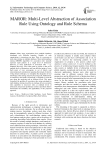
MAROR: Multi-Level Abstraction of Association Rule Using Ontology and Rule Schema
Статья научная
Many large organizations have multiple databases distributed over different branches. Number of such organizations is increasing over time. Thus, it is necessary to study data mining on multiple databases. Most multi-databases mining (MDBM) algorithms for association rules typically represent input patterns at a single level of abstraction. However, in many applications of association rules – e.g., Industrial discovery, users often need to explore a data set at multiple levels of abstraction, and from different points of view. Each point of view corresponds to set of beliefs (and representational) commitments regarding the domain of interest. Using domain ontologies, we strengthen the integration of user knowledge in the mining and post-processing task. Furthermore, an interactive and iterative framework is designed to assist the user along the analyzing task at different levels. This paper formalizes the problem of association rules using ontologies in multi-database mining, describes an ontology-driven association rules algorithm to discoverer rules at multiple levels of abstraction and presents preliminary results in petroleum field to demonstrate the feasibility and applicability of this proposed approach.
Бесплатно
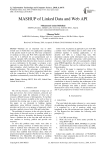
MASHUP of linked data and Web API
Статья научная
Mashups are an important way to allow normal users to build their own applications responding to the specific needs of each one. The basic components of mashups are Data and Web APIs especially Restful ones, but it is difficult for an unexperienced user to combine manually APIs with Data. Therefore, there is a need to predefine links between these resources to permit an easy combination. In this paper, we propose a new approach to make Restful Web APIs adhere to Linked Data principles, which facilitate their combination in mashup applications. The advantage of the proposed approach is the fact that it allows integrating linked data with the composition of Restful APIs, It also uses an algorithm to automatically create links between APIs.
Бесплатно
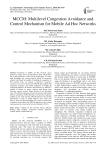
MCCM: Multilevel Congestion Avoidance and Control Mechanism for Mobile Ad Hoc Networks
Статья научная
Congestion in Mobile Ad Hoc Network causes packet loss, longer end-to-end data delivery delay which affects the overall performance of the network significantly. To ensure high throughput, the routing protocol should be congestion adaptive and should be capable of handling the congestion. In this research work, we propose a Multilevel Congestion avoidance and Control Mechanism (MCCM) that exploits both congestion avoidance and control mechanism to handle the congestion problem in an effective and efficient way. MCCM is capable of finding an energy efficient path during route discovery process, provide longer lifetime of any developed route. The efficient admission control and selective data packet delivery mechanism of MCCM jointly overcome the congestion problem at any node and thus, MCCM improves the network performance in term of packet delivery ratio, lower data delivery delay and high throughput. The result of performance evaluation section shows that, MCCM outperforms the existing routing protocols carried out in Network Simulator-2(NS-2).
Бесплатно
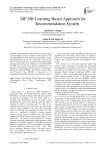
MF-NB learning based approach for recommendation system
Статья научная
The Multi Factor-Naive Bayes classifier based recommendation system is analyzed with respect to the traditional KNN classifier based recommendation system. The classification of the web usage data is done on the basis of the keyword name, keyword count, inbound links and age group of the users. Whereas, in traditional KNN the URL was the only factor that was considered for the purpose of classification. The performance evaluation is done in the terms of RMSE, Error Rate, Accuracy Rate and Precision. The MF-NB is observed to be outperforming the KNN classifier in all respective terms.
Бесплатно
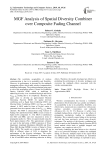
MGF analysis of spatial diversity combiner over composite fading channel
Статья научная
The worldwide acceptability of wireless communication is due to its portability and flexibility. However, its performance is governed by the multipath propagation effects which make wireless communication modelling challenging. The existing technique being used to solve this propagation effects is based on Probability Density Function (PDF) which is inefficient in addressing diversity over combined Rayleigh and Rician (C_(Ray-Ric)) fading due to its complexity. Therefore, this paper aims to develop an approximated Moment Generating Function (MGF) for spatial diversity combining such as Equal Gain Combining (EGC) and Maximal Ratio Combining (MRC) over C_(Ray-Ric) fading channel. A MGF model in form of Taylor’s series is generated from the expected value of the C_(Ray-Ric) fading channels. The MGF is characterized using Amount of Fading (AF) and Bit Error Rate (BER) in term of Line of Sight (LOS) component ‘k’. The MGF is transformed into EGC and MRC, and were measured in terms of propagation paths (L). These are approximated using the Pade ́ Approximation (PA). The approximates obtained are used in the derivation of BER expression of M-ary Quadrature Amplitude Modulation (MQAM) and M-ary Phase Shift Keying (MPSK) in terms of Signal to Noise Ratio (SNR). The models are evaluated using AF and BER at different values of LOS to determine the performance of the diversity techniques. The results obtained show that as LOS component ‘k’ increases from 0, the Af and BER reduce indicating reduction in fading effects. Therefore, the models developed are effective in predicting the performance of diversity techniques and overcome the multipath effects associated with the wireless communication.
Бесплатно
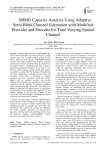
Статья научная
Multiple Input Multiple Output(MIMO) has been in much importance in recent past because of high capacity gain over a single antenna system. In this article, analysis over the capacity of the MIMO channel systems with spatial channel with modified precoder and decoder has been considered when the channel state information (CSI) is considered partial. Due to delay in acquiring transmitted information at the receiver end, the time selective fading wireless channel often induces incomplete or partial CSI. The dynamic CSI model has also been implemented consisting channel mean and covariance which leads to extracting of channel estimates and error covariance which then further applied with the modified precoder and decoder utilizing both the parameters indicating the CSI quality since these are the functions of temporal correlation factor, and based on this, the model covers data from perfect to statistical CSI, either partially or fully blind. It is found that in case of partial and imperfect CSI, the capacity depends on the statistical properties of the error in the CSI which has been manipulated according to the precoder and decoder conditions. Based on the knowledge of statistical distribution of the deviations in CSI knowledge, a new approach which maximizes the capacity of spatial channel model with modified precoder and decoder has been tried. The interference then interactively reduced by employing the iterative channel estimation and data detection approach, where by utilizing the detected symbols from the previous iteration, multiuser/MIMO channel estimation and symbol detection is improved.
Бесплатно

MOTIFSM: Cloudera Motif DNA Finding Algorithm
Статья научная
Many studying systems of gene function work depend on the DNA motif. DNA motifs finding generate a lot of trails which make it complex. Regulation of gene expression is identified according to Transcription Factor Binding Sites (TFBSs). There are different algorithms explained, over the past decades, to get an accurate motif tool. The major problems for these algorithms are on the execution time and the memory size which depend on the probabilistic approaches. Our previous algorithm, called EIMF, is recently proposed to overcome these problems by rearranging data. Because cloud computing involves many resources, the challenge of mapping jobs to infinite computing resources is an NP-hard optimization problem. In this paper, we proposed an Impala framework for solving a motif finding algorithms in single and multi-user based on cloud computing. Also, the comparison between Cloud motif and previous EIMF algorithms is performed in three different motif group. The results obtained the Cloudera motif was a considerable finding algorithms in the experimental group that decreased the execution time and the Memory size, when compared with the previous EIMF algorithms. The proposed MOTIFSM algorithm based on the cloud computing decrease the execution time by 70% approximately in MOTIFSM than EIMF framework. Memory size also is decreased in MOTIFSM about 75% than EIMF.
Бесплатно

